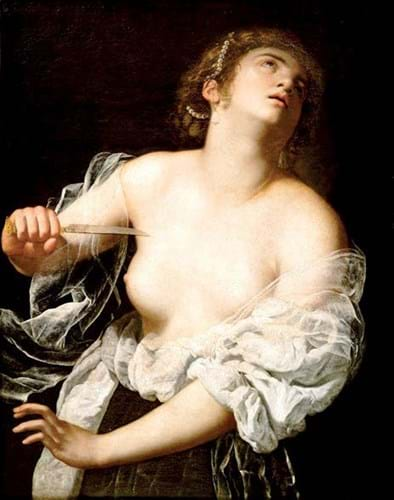Lucretia by Gentileschi was sold to dealer Patrick Matthiesen of The Matthiesen Gallery for €4m/£3.4m (plus buyer’s premium) at Artcurial’s sale of November 13, 2019.
The Matthiesen Gallery has now sold it to the Getty Museum.
The painting had previously been in a private collection in Lyon prior to the 2019 auction.
The oil on canvas, 3ft 2in x 2ft 5in (96 x 75cm), shows the ancient Roman heroine preparing to commit suicide following her rape.
The Getty said the painting represents the artist at the height of her expressive powers, and demonstrates her ambition for depicting historical subjects, something that was virtually unprecedented for a female artist in her day.
The subject, which Gentileschi painted several times over the course of her career, had very personal significance for her: like Lucretia, the Roman heroine who took her own life after having been raped, Artemisia had experienced sexual violence as a young woman.
“Outstanding ability”
Timothy Potts, the Maria Hummer-Tuttle and Robert Tuttle director of the J Paul Getty Museum, said: “Although renowned in her day as a painter of outstanding ability, Artemisia suffered from the long shadow cast by her more famous and celebrated father Orazio Gentileschi (of whom the Getty has two major works, Lot and His Daughters and the recently acquired Danaë and the Shower of Gold).
“A thorough reassessment of her place in baroque art had to wait until the late 20th century, since when she has become one of the most sought-after painters of the 17th century. Her achievement as a painter of powerful and dramatic history subjects is all the more remarkable for the abuse and prejudice that she suffered in her personal life—and which is palpably present in Lucretia’s suicide, and other of her paintings where the central protagonist is a wronged or abused woman.
“In this and many other ways, Artemisia’s Lucretia will open a window for our visitors onto important issues of injustice, prejudice, and abuse that lie below the beguilingly beautiful surfaces of such works.”
According to the History of Rome (Book I, 57-59) by ancient Roman historian Livy, Lucretia was the wife of the nobleman Lucius Tarquinius Collatinus. After her rape by Sextus Tarquinius, the son of the King, she called on her father and her husband for vengeance and then, while proclaiming her innocence and chastity, stabbed herself to death. Her tragic gesture led to a rebellion that drove the Tarquins from Rome and marked the foundation of the Roman Republic.
As an example of female strength and courage, Lucretia became a favorite subject in Renaissance and Baroque art, often depicted isolated in the moment just before she plunges the dagger in her chest.
The Getty believed the picture may have been painted during her time in Venice in the late 1620s.
Lucretia will be on view when the museum reopens to the public in the coming weeks in Los Angeles.
A Gentileschi oil of the same subject sold at Dorotheum in 2018 for €1.6m.
Her depiction of St Catherine of Alexandria sold for €1.85m (£1.63m) at Christophe Joron-Derem at Drout in Paris, 2017. That picture now hangs in the National Gallery. The London museum bought it for £3.6m from London dealership Robilant & Voena in 2018.
The National Gallery held an exhibition on the artist that ended in January this year.
This article was corrected on April 14 to note that the picture was sold to the Getty by dealer Patrick Matthiesen.







